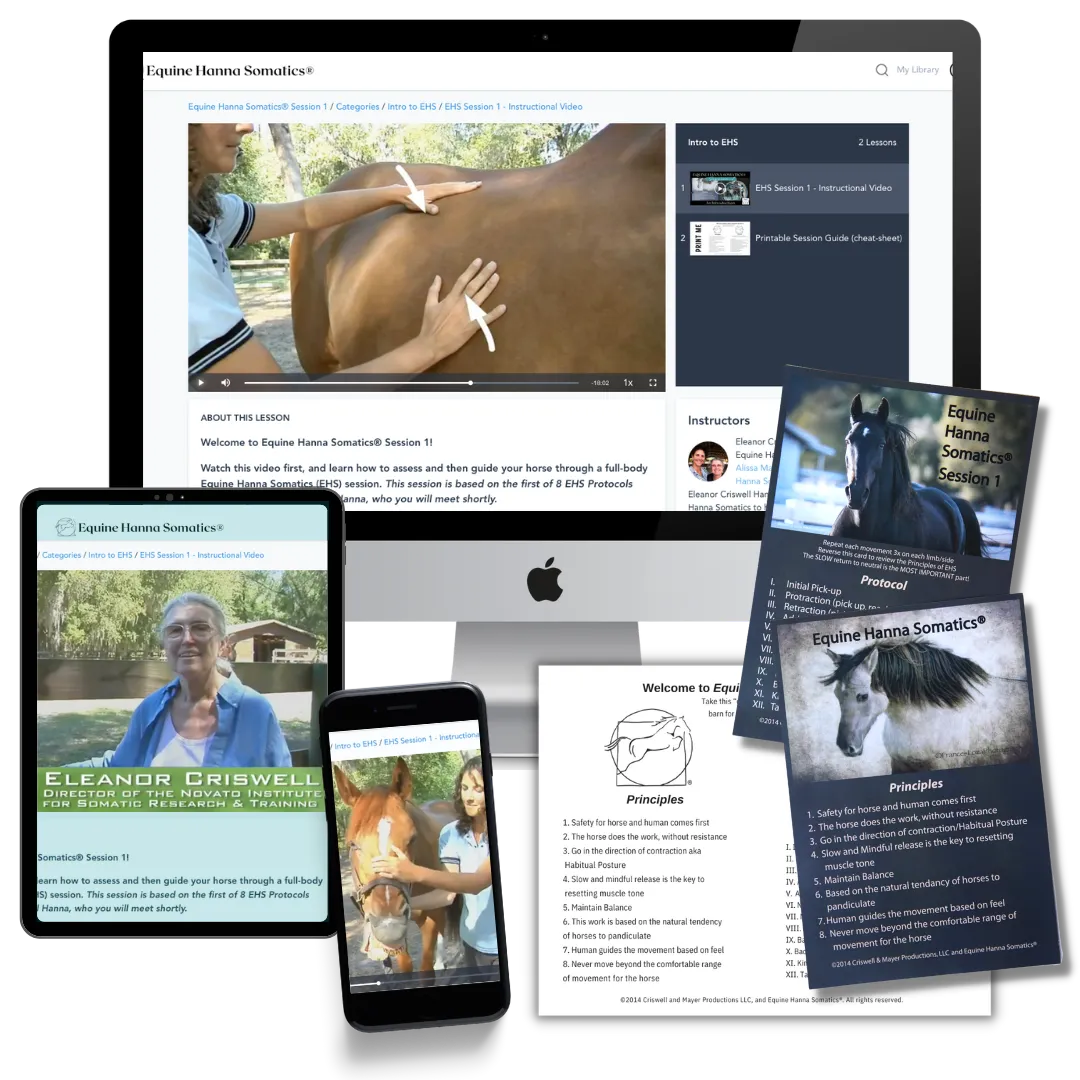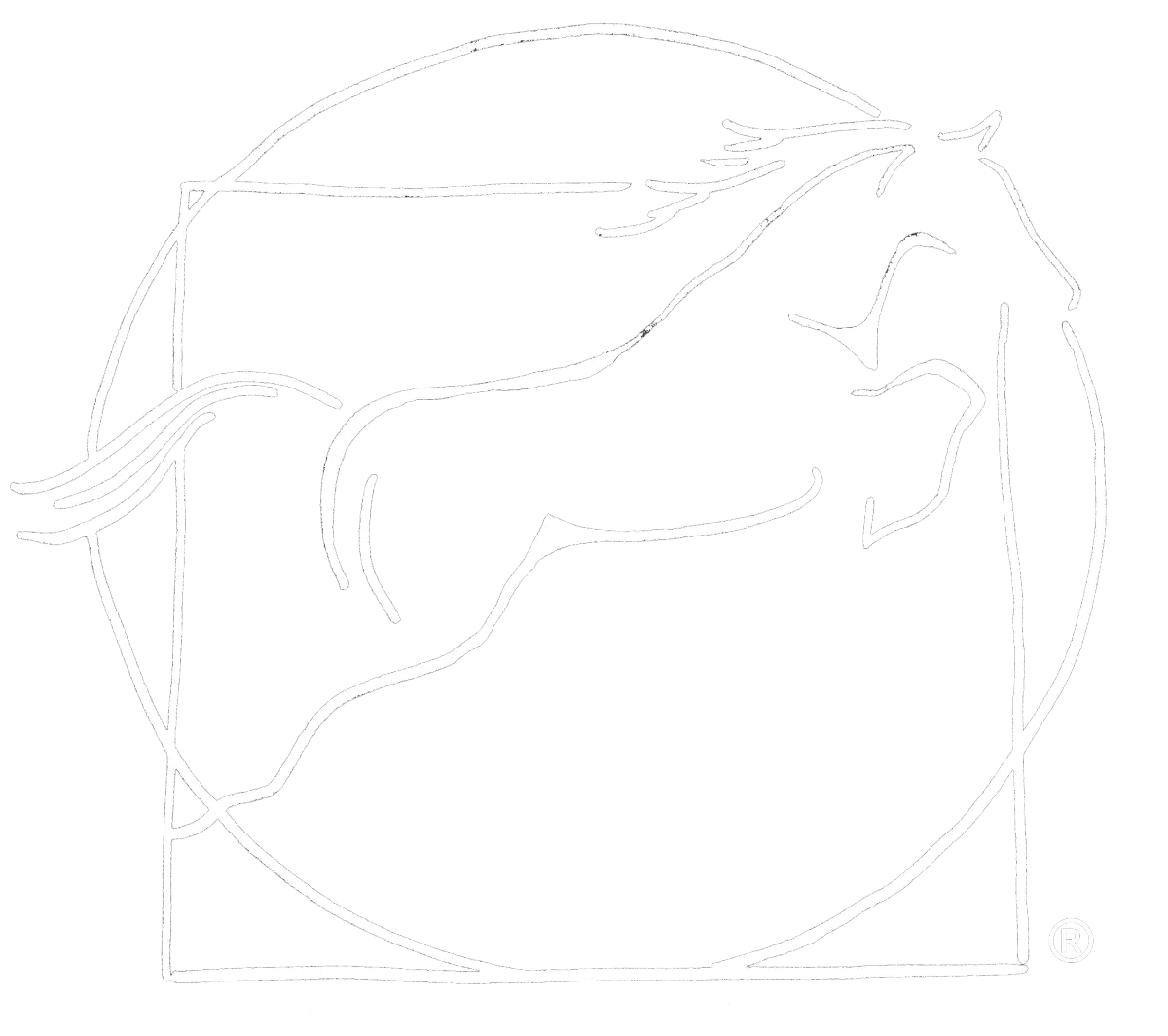Pandiculation vs. Stretching for Horses
Pandiculation is a naturally occurring reflexive contraction of the whole body (or its parts), which is then followed by a slow release of the contraction, as seen in all healthy animals. You may not know it, but you have been doing pandiculations your whole life. You’ve seen a cat or dog pandiculate after waking from a nap, and you may have even seen a horse do it too.
Pandiculation is an important part of the self-care and self-regulation managed by the parasympathetic nervous system in all animals, and is generally a wonderful sign of health and well-being.
Why do horses pandiculate?
Pandiculation is a natural behavior that contributes to the development and maintenance of a horses neuromuscular integrity and mind-body integration at all ages and stages of life.
All animals spontaneously pandiculate, typically after a period of inactivity like sleeping or being confined. Pandiculation can be done standing or laying down (ie. recumbent), and looks like a symmetrical full-body stretch, often accompanied by a yawn - or it can involve just one or two limbs at a time, or one limb and the neck, or wing… there are many variations on the ways different animals pandiculate.
Foals even pandiculate in their mother’s womb, and have been observed pandiculating up to 80 times per day after being born, as soon as on their 3rd day of life! (McGreevy 2012 p.166)

Pandiculation vs. Traditional Stretching
Although often described as a type of ‘stretching,’ pandiculation is actually the opposite of stretching. Instead of muscle fibers being mechanically lengthened - as happens during a stretch - pandiculation is a polysynaptic reflex that starts with a muscle contraction - the lengthening is secondary. When one muscle contracts, it is known as the agonist, and the muscle that works in the opposite direction, called the antagonist, passively lengthens to allow the agonist to contract without resistance. This is automatically facilitated by the nervous system via a reflex called reciprocal inhibition.
After the contraction, which moves the body into the classic postures historically labeled as stretching, the next part of the pandiculation involves the gradual, luxurious self-mediated lengthening of the contracted muscles. This slow coming out of the contraction is achieved by several volleys of inhibitory motor impulses coming from the central nervous system to stop the muscle fibers from shortening bit by bit, which allows the body parts to return to a neutral position and posture.
At no point in a pandiculation are the muscles that were shortening also pulled into a stretch.
A stretch, whether self-applied or applied to the body from the outside by a practitioner, is a mechanical lengthening of muscle fibers achieved by using leverage and forces to pull on the body, and generally does not include ANY of the motor neuron activity involved in pandiculation, but does provide sensory input to the spinal cord and brain. Stretching muscles frequently also triggers the stretch reflex, which causes the muscle to contract again and return to it’s pre-stretch length.
Said another way, pandiculation is something you DO, an action that comes from inside the nervous system, and stretching is something that happens TO your body.
Why do horses pandiculate less than dogs/cats?
Unfortunately the answer isn't an easy one, but it needs to be said. The main reason we don't see most horses pandiculating very often is likely because most domestic horses are not sound - according to a study of 299 horses competing in the FEI, 88% of horses competing and training are NOT SOUND (Contino et al. 2023). And when horses are in pain or are ill, they tend to pandiculate less than normal.
What is normal? Well, we know foals have been observed to pandiculate up to 80 times per day, but around the world it's typical for horses to pandiculate less and less as they age.
I have observed horses spontaneously pandiculate during or after some bodywork experiences, frequently during Equine Hanna Somatics® sessions, and I've also observed horses that are lucky to be changed to more healthy training methods start to pandiculate more often.
Other factors that likely contribute are that as prey animals, horses typically spend more time on their feet and moving around than predators - that is if they have the space to move and are not confined. By moving, their muscles don't stay in a shortened state as often or for as long as happens when a dog or cat curls up to sleep. The purpose of pandiculation, (or one of them, as far as we know), is to return shortened muscles to a neutral resting length so they can be ready to lengthen or shorten for movement, as needed - so it makes sense that animals that sleep or sit still more often would need to pandiculate more often (after they wake or rise from being recumbent).
What is Voluntary Pandiculation?
Voluntary Pandiculation is a wholly unique technique developed by Thomas Hanna (and later named by Eleanor Criswell) for Hanna's groundbreaking work with humans known as Hanna Somatic Education® (sometimes called Clinical Somatic Education). In 1995, Eleanor Criswell began applying the principles of Hanna Somatics to horses, and developed the Equine Hanna Somatics® (EHS) protocols and EHS Professional Training Program.
Voluntary Pandiculation is based on the tendency of animals (including humans) to pandiculate as a natural reflex. Voluntary Pandiculation exercises are something that one can only do with one's own body while actively avoiding the stretching of any muscles! The hallmark observable result of doing voluntary pandiculation is an immediate resetting of resting muscle tonus, a restoration of fuller muscular control and increased body awareness. This allows a horse’s nervous system to make adjustments based on sensory inputs to improve the accuracy and efficiency of the horses motor outputs that control movement and posture, and leads to the many other benefits and profound results commonly achieved by practicing Hanna Somatics.
Learn to Voluntarily Pandiculate
Every Equine Hanna Somatics session, whether you are doing the basic exercises from our intro course yourself, or have hired a certified or student EHS Educator to work with your horse, includes a series of voluntary pandiculation exercises tailored to the horses individual needs, based on their current habitual posture and maladaptive compensation patterns.
RESOURCES
A.F. Fraser, Pandiculation: the comparative phenomenon of systematic stretching, Applied Animal Behaviour Science, Volume 23, Issue 3, 1989, Pages 263-268, ISSN 0168-1591, https://www.sciencedirect.com/science/article/abs/pii/0168159189901172?via%3Dihub
Bertolucci L. F. (2011). Pandiculation: nature's way of maintaining the functional integrity of the myofascial system?. Journal of bodywork and movement therapies, 15(3), 268–280. https://doi.org/10.1016/j.jbmt.2010.12.006
Contino E, Daglish J, Kawcak C. The prevalence of lameness in FEI equine athletes and its correlation to performance. Proceedings of the American Association of Equine Practitioners 2023; 69: 369-370.
Criswell, E. & Mayer, A. (2006-2025) Equine Hanna Somatics® Professional Training Program Manual
Hanna, T. (1988) Somatics - Reawakening the Mind’s Control of Movement, Flexibility and Health. Da Capo Press
McGreevy, P. (2012). Equine Behavior, A Guide for Veterinarians and Equine Scientists (2nd ed.) Saunders Elsevier




